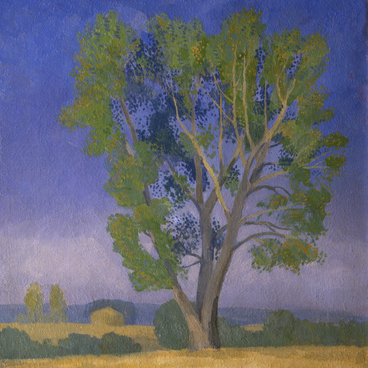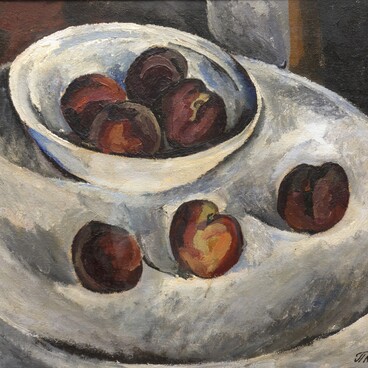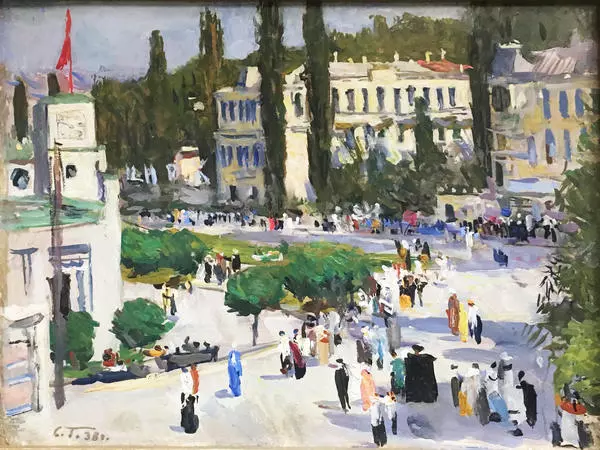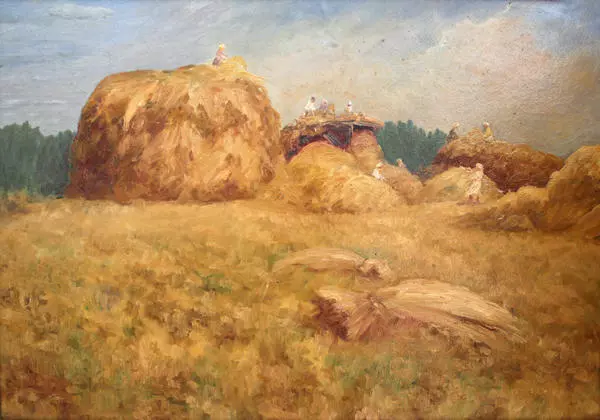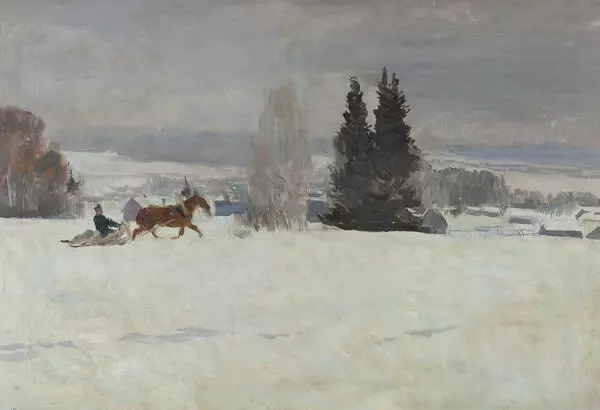Most of Gerasimov’s landscape works are devoted to the nature in central Russia, in the environs of his hometown of Mozhaisk. Simple motifs familiar from his childhood, deeply felt, are traced in all their details and with their hourly changes, and the artist’s best works take on the tone of philosophical generalizations.
His landscapes created following trips abroad differ from his paintings of Russian nature. They swiftly, accurately capture the originality inherent in various countries and cities that revealed itself to the artist thanks to his vast experience and keenness of perception, in all their peculiarities of color, lighting, and atmosphere, and in their architectural specifics and the emotional vibes of life.
The landscape from the Radishchev Museum Paris. Near the Louvre (1956) captures a corner of the famous Tuileries Garden, a classic French ordinary park with clearly laid out alleys, gravel paths, lawns with flowers,
and decorative vases and sculptures. Silence reigns here, and as if filled with memories of the past, everything is steeped in the spirit of art, and exquisite, carefully guarded beauty.
The painting was painted in an unconstrained, sketchy manner, in accordance with the basic principles of plein air painting: striving to recreate the state of the environment of light and air as truthfully as possible, the artist tried to capture the subtlest nuances of lighting and color overtones, which only the perception of a great artist can grasp. The soft, diffused light emanating from lightweight, pearly pink clouds, highlighted by the rays of the setting sun, the tree crowns darkening against the background of a bright sky, the dusk deepening in the depths of the alleys, a moist bluish haze rising from the ground, softening the outlines of all objects and slightly muting the contrasts in color - all of these marvelously convey the atmosphere of a cool summer evening.
The space of the deserted park is enlivened by the lone figure of a slender, red-haired woman emerging from the gate in an elegant black-and-white suit. Her unhurried movement evokes a mood of dreamy, poetic thoughtfulness, and the refined elegance of a strict silhouette attests to the fact that this stellar work by Gerasimov belongs to a completely definite era - the 1950s - as well as to the authentic painting skill of an artist that not only had an outstanding ‘sense of place’, but also an amazing ability to convey the feeling of his time using extremely concise methods.
The landscape from the Radishchev Museum Paris. Near the Louvre (1956) captures a corner of the famous Tuileries Garden, a classic French ordinary park with clearly laid out alleys, gravel paths, lawns with flowers,
and decorative vases and sculptures. Silence reigns here, and as if filled with memories of the past, everything is steeped in the spirit of art, and exquisite, carefully guarded beauty.
The painting was painted in an unconstrained, sketchy manner, in accordance with the basic principles of plein air painting: striving to recreate the state of the environment of light and air as truthfully as possible, the artist tried to capture the subtlest nuances of lighting and color overtones, which only the perception of a great artist can grasp. The soft, diffused light emanating from lightweight, pearly pink clouds, highlighted by the rays of the setting sun, the tree crowns darkening against the background of a bright sky, the dusk deepening in the depths of the alleys, a moist bluish haze rising from the ground, softening the outlines of all objects and slightly muting the contrasts in color - all of these marvelously convey the atmosphere of a cool summer evening.
The space of the deserted park is enlivened by the lone figure of a slender, red-haired woman emerging from the gate in an elegant black-and-white suit. Her unhurried movement evokes a mood of dreamy, poetic thoughtfulness, and the refined elegance of a strict silhouette attests to the fact that this stellar work by Gerasimov belongs to a completely definite era - the 1950s - as well as to the authentic painting skill of an artist that not only had an outstanding ‘sense of place’, but also an amazing ability to convey the feeling of his time using extremely concise methods.


